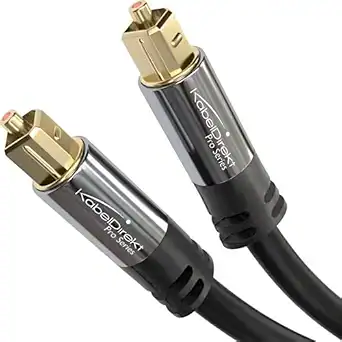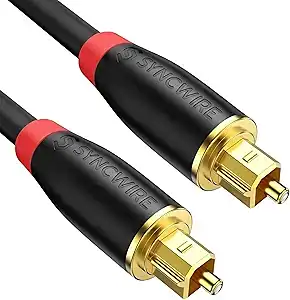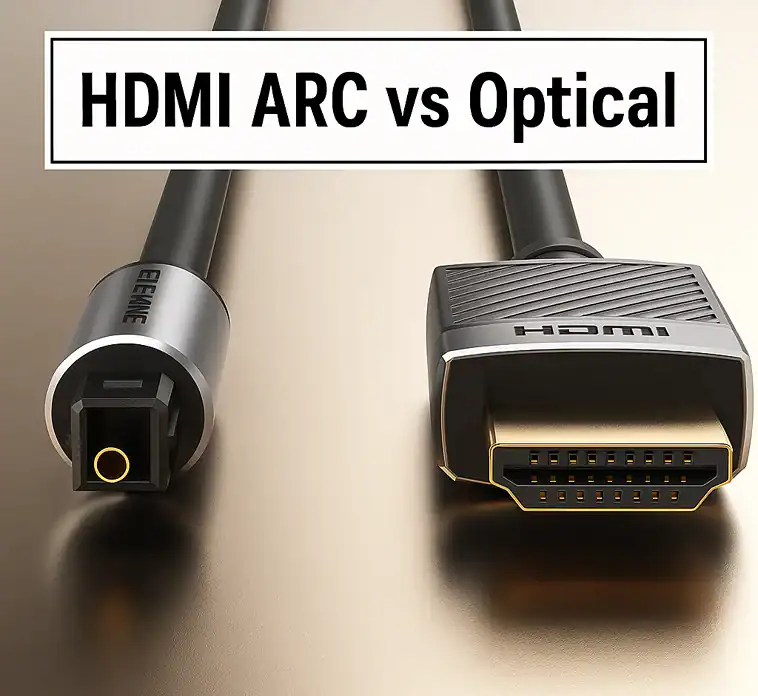Optical audio and HDMI ARC (Audio Return Channel) are the two most common ways to transfer the digital audio signal from the TV to the external audio system. Both have different features that make them suitable for different types of installations. Although both can carry high-quality digital audio without the interference problems that often occur with analog connections, they considerably differ in their features, convenience, and compatibility with the latest ‘audio formats’.
ARC over HDMI aims to provide the convenience of a single-cable solution complete with the support of advanced audio codecs and device control features, while an optical connection offers the advantages of universal compatibility and ease of use, albeit with more ‘limited bandwidth’. Knowing the main differences between these technologies will allow you to decide on the best way to connect your home entertainment system, whether you have a simple soundbar or an elaborate surround sound setup.
HDMI ARC vs Optical Cables
Choosing the best audio connection is very crucial if you want the best sound quality while creating your home theater setup. One of the possibilities is HDMI ARC and optical cables. On one hand, they are similar in that they allow the audio from the television to be sent to an external device, for example, a soundbar or an AV receiver, but on the other hand, they are different in their working principles.
An HDMI port can be used to send a ‘digital audio signal’ through HDMI ARC (Audio Return Channel), which is compatible with high-quality formats (e.g., DTS HD Master Audio and Dolby Atmos) for home theaters. On the other hand, optical cables carry audio using light signals through fiber optics, and they support fewer formats. If you are aware of the differences between them, you will be in a position to ‘choose the best option’ that suits your requirements.
HDMI ARC & Optical Cable – Main Differences
HDMI ARC and optical cables are different in that they transmit the sound from a TV to an external audio device, but in terms of sound quality, formats supported, and features, they vary.
HDMI ARC is notable for its feature of sending video signals with uncompressed surround sound, which is perfect for modern home theaters. Optical cables, on the other hand, are still reliable, can only carry uncompressed PCM audio and compressed audio, and thus are less powerful.
Moreover, using only one HDMI cable for both sound and video, HDMI ARC cables can make setup easier. To create long-distance connections, active HDMI cables are required. Optical cables can carry signals over longer distances without loss, which makes them very suitable when the length of the cable is the main issue.
What Is HDMI ARC?

HDMI ARC (Audio Return Channel) is a feature that enables a TV to send a sound output to a sound system via an HDMI port without providing an additional cable. It also facilitates the process of carrying the audio signals, thus making it less complex.
Features of HDMI ARC
- ‘Dolby Atmos and DTS HD Master Audio’ are the multi-channel audio formats mentioned here that are supported.
- These standard HDMI cables are also used for the connection; thus, the audio cable is no longer necessary.
- Facilitates a clean audio signal by reducing signal loss.
- Allows Consumer Electronics Control (CEC) to be used, and thus a ‘single TV remote’ can control the AV receiver or soundbar.
- Works well with streaming devices, Blu-ray players, and game consoles.
- Almost all new TVs come with an ‘HDMI ARC port or an HDMI eARC’ connection (Enhanced Audio Return Channel).
- Soundbars and AV receivers that are in line with Dolby Digital and some other good quality audio formats are going to be on.
- HDMI peripherals like gaming consoles, media streamers, and home theater systems.
What Is an Optical Cable?

A TOSLINK optical audio cable uses fiber optics to convey digital audio signals in the form of light. It is an alternative to HDMI ARC for transferring audio data from a TV to an external speaker or a sound system.
Features of Optical Cables (TOSLINK)
- It supports uncompressed stereo audio and certain audio formats like Dolby Digital, but it does not support formats such as Dolby Atmos.
- Caters to the quality of audio that is high, with lowered electromagnetic interference.
- Good for use at greater distances without loss of signal.
- Needs an additional cable to transmit video.
- It has no provision for control signals, hence the users may have to resort to multiple remotes to alter the audio settings.
Major Contrasts: HDMI ARC vs. Optical Cables
Audio Quality and Formats Supported
- The ARC feature on HDMI has the capability of carrying audio of higher quality that is not compressed, like Dolby Atmos, DTS HD Master Audio, and uncompressed surround sound.
- Optical connections can only send audio in the form of uncompressed PCM. The formats that are compressed, such as Dolby Digital, are not included.
Device Compatibility
- Most of the contemporary TVs and AV receivers have an HDMI ARC port that allows them to be compatible with soundbars and home theater systems without any hassles.
- The optical cables continue to be very popular among the old TVs and the audio devices that lack an HDMI ARC connection, and thus, they still need to use the optical cables.
Ease of Setup and Connectivity
- HDMI ARC makes the connection easier to a certain degree, as it only requires one HDMI cable, which carries both audio and video signals.
- With optical cables, video has to be connected separately, hence the setup is a little more complicated than with the audio.
Audio Delay and Latency
- HDMI ARC has a lower latency because of the direct audio transmission, and therefore, it provides a better sound quality.
- Optical cables may cause some small delays, thus they become less suitable for gaming and listening to audio that is in real-time.
Cable Length and Durability
- Active HDMI cables are required for longer distances, whereas passive HDMI cables are appropriate for shorter ones.
- Optical cables are not subject to loss of quality over longer distances, thus they ensure reliable performance when the length of the cable is an issue.
Additional Features
- HDMI ARC supports Consumer Electronics Control (CEC), enabling users to ‘manage multiple devices’ with only one remote.
- More ‘capacity to transport higher quality audio formats’ is offered by HDMI eARC.
- Optical cables are not CEC compatible and hence require manual operation of connected devices.
HDMI ARC

Pros:
- Uncompressed surround sound up to Dolby Atmos and DTS HD Master Audio is supported, hence the sound will be of better quality.
- One HDMI cable carries both audio and video, which leads to less clutter.
- In case of use with CEC, the TV remote control can also operate the AV receiver or the soundbar, thus saving the number of remotes.
- Moreover, the eARC feature makes the bandwidth higher and the latency lower; thus, the performance will be extremely good.
Cons:
- Passive HDMI cable length is restricted; however, longer distances require active HDMI cables.
- Some old TVs and devices may lack support for HDMI ARC.
- If you use devices from different brands, you might have setting conflicts.
Optical Cables

Pros:
- Signal loss or interference is not an issue when using long distances.
- The devices are compatible with old TVs and audio systems.
- It gives uncompressed PCM audio, thus good audio performance can be expected.
- It is reliable for dedicated audio transmission with minimal cabling.
Cons:
- The main limitation in using optical cables will be the support of only compressed formats like Dolby Digital—Dolby Atmos, or uncompressed surround formats are not allowed.
- Needs other video cables, which complicates the setup.
- Does not have CEC, which is why you will have to use more remotes.
- It is not capable of sending video, thus restricting the applications in modern installations.
Which One Should You Choose?
The choice of using either ‘HDMI ARC or optical cables’ is based on your audio configuration and the quality of sound you have. ‘HDMI ARC is the perfect option’ if you need better audio quality, higher audio formats, and fewer wires. It enables one HDMI cable to carry both audio and video, and it supports Dolby Atmos and uncompressed surround sound.
Contrastingly, optical cables can be a suitable alternative if your ‘TV or audio device’ does not have an HDMI ARC port and is of an older generation. They are still good for ‘long-range audio’ and also remove the interference; however, they cannot carry uncompressed or high-quality audio formats.
If your setup comprises a modern AV receiver, a soundbar, or a gaming console, then HDMI ARC would be the most suitable choice.
FAQs
Does ARC require a special HDMI cable?
When compared to optical, does HDMI ARC enhance sound quality?
Can I use HDMI ARC and Optical together?
Why is my HDMI ARC not working?
Is Optical still a good choice in 2025?
Conclusion
The decision between HDMI ARC and optical cables hinges upon your ‘audio system and the level of quality’ you desire.
HDMI ARC offers improved sound, compatibility with more formats, and makes setup simpler. Optical cables are definitely still handy, but they have no support for uncompressed audio and also need separate cables for video—this makes them good only for old systems.

















